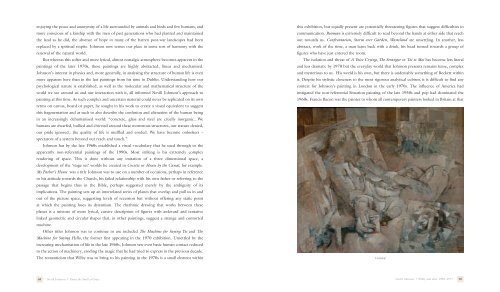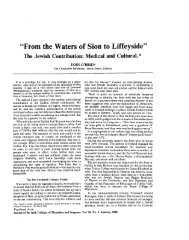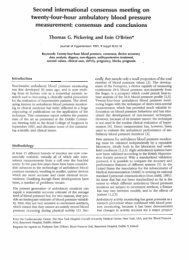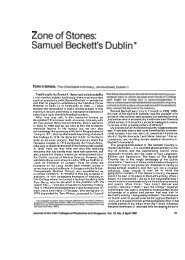Nevill Johnson: Paint the smell of grass - Eoin O'Brien
Nevill Johnson: Paint the smell of grass - Eoin O'Brien
Nevill Johnson: Paint the smell of grass - Eoin O'Brien
Create successful ePaper yourself
Turn your PDF publications into a flip-book with our unique Google optimized e-Paper software.
enjoying <strong>the</strong> peace and anonymity <strong>of</strong> a life surrounded by animals and birds and few humans, and<br />
more conscious <strong>of</strong> a kinship with <strong>the</strong> men <strong>of</strong> past generations who had planted and maintained<br />
<strong>the</strong> land as he did, <strong>the</strong> absence <strong>of</strong> hope in many <strong>of</strong> <strong>the</strong> barren post-war landscapes had been<br />
replaced by a spiritual respite. <strong>Johnson</strong> now senses our place in some sort <strong>of</strong> harmony with <strong>the</strong><br />
renewal <strong>of</strong> <strong>the</strong> natural world.<br />
But whereas this s<strong>of</strong>ter and more lyrical, almost nostalgic atmosphere becomes apparent in <strong>the</strong><br />
paintings <strong>of</strong> <strong>the</strong> later 1970s, <strong>the</strong>se paintings are highly abstracted, linear and mechanised.<br />
<strong>Johnson</strong>’s interest in physics and, more generally, in analysing <strong>the</strong> structure <strong>of</strong> human life is even<br />
more apparent here than in <strong>the</strong> last paintings from his time in Dublin. Understanding how our<br />
psychological nature is established, as well as <strong>the</strong> molecular and ma<strong>the</strong>matical structure <strong>of</strong> <strong>the</strong><br />
world we see around us and our interaction with it, all informed <strong>Nevill</strong> <strong>Johnson</strong>’s approach to<br />
painting at this time. As such complex and uncertain material could never be replicated on its own<br />
terms on canvas, board or paper, he sought in his work to create a visual equivalent to suggest<br />
this fragmentation and as such to also describe <strong>the</strong> confusion and alienation <strong>of</strong> <strong>the</strong> human being<br />
in an increasingly dehumanised world: “concrete, glass and steel are cruelly inorganic…We<br />
humans are dwarfed, bullied and chivvied around <strong>the</strong>se monstrous structures, our stature denied,<br />
our pride ignored…<strong>the</strong> quality <strong>of</strong> life is muffled and eroded. We have become onlookers –<br />
spectators <strong>of</strong> a system beyond our reach and touch.”<br />
<strong>Johnson</strong> has by <strong>the</strong> late 1960s established a visual vocabulary that he used through to <strong>the</strong><br />
apparently non-referential paintings <strong>of</strong> <strong>the</strong> 1990s. Most striking is his extremely complex<br />
rendering <strong>of</strong> space. This is done without any imitation <strong>of</strong> a three dimensional space, a<br />
development <strong>of</strong> <strong>the</strong> ‘stage set’ worlds he created in Cocotte or House by <strong>the</strong> Canal, for example.<br />
68 <strong>Nevill</strong> <strong>Johnson</strong> l <strong>Paint</strong> <strong>the</strong> Smell <strong>of</strong> Grass<br />
this exhibition, but equally present are potentially threatening figures that suggest difficulties in<br />
communication. Bossman is extremely difficult to read beyond <strong>the</strong> hands at ei<strong>the</strong>r side that reach<br />
out towards us. Confrontation, Storm over Garden, Wasteland are unsettling. In ano<strong>the</strong>r, less<br />
abstract, work <strong>of</strong> <strong>the</strong> time, a man leans back with a drink, his head turned towards a group <strong>of</strong><br />
figures who have just entered <strong>the</strong> room.<br />
The isolation and threat <strong>of</strong> A Voice Crying, The Stranger or Toi et Moi has become less literal<br />
and less dramatic by 1970 but <strong>the</strong> everyday world that <strong>Johnson</strong> presents remains tense, complex<br />
and mysterious to us. His world is his own, but <strong>the</strong>re is undeniably something <strong>of</strong> Beckett within<br />
it. Despite his stylistic closeness to <strong>the</strong> most rigorous analytical cubism, it is difficult to find any<br />
context for <strong>Johnson</strong>’s painting in London in <strong>the</strong> early 1970s. The influence <strong>of</strong> America had<br />
instigated <strong>the</strong> non-referential Situation painting <strong>of</strong> <strong>the</strong> late 1950s and pop had dominated <strong>the</strong><br />
1960s. Francis Bacon was <strong>the</strong> painter to whom all contemporary painters looked in Britain at that<br />
My Fa<strong>the</strong>r’s House was a title <strong>Johnson</strong> was to use on a number <strong>of</strong> occasions, perhaps in reference<br />
to his attitude towards <strong>the</strong> Church, his failed relationship with his own fa<strong>the</strong>r or referring to <strong>the</strong><br />
passage that begins thus in <strong>the</strong> Bible, perhaps suggested merely by <strong>the</strong> ambiguity <strong>of</strong> its<br />
implications. The painting sets up an interrelated series <strong>of</strong> planes that overlap and pull us in and<br />
out <strong>of</strong> <strong>the</strong> picture space, suggesting levels <strong>of</strong> recession but without <strong>of</strong>fering any static point<br />
at which <strong>the</strong> painting loses its dynamism. The rhythmic drawing that works between <strong>the</strong>se<br />
planes is a mixture <strong>of</strong> more lyrical, cursive description <strong>of</strong> figures with awkward and tentative<br />
linked geometric and circular shapes that, in o<strong>the</strong>r paintings, suggest a strange and contorted<br />
machine.<br />
O<strong>the</strong>r titles <strong>Johnson</strong> was to continue to use included The Machine for Saying Yes and The<br />
Machine for Saying Hello, <strong>the</strong> former first appearing in <strong>the</strong> 1970 exhibition. Unsettled by <strong>the</strong><br />
increasing mechanisation <strong>of</strong> life in <strong>the</strong> late 1960s, <strong>Johnson</strong> saw even basic human contact reduced<br />
to <strong>the</strong> action <strong>of</strong> machinery, eroding <strong>the</strong> magic that he had tried to express in <strong>the</strong> previous decade.<br />
The romanticism that Wilby was to bring to his painting in <strong>the</strong> 1970s is a small element within Untitled<br />
<strong>Nevill</strong> <strong>Johnson</strong> l Wilby and after 1959–1977 69









